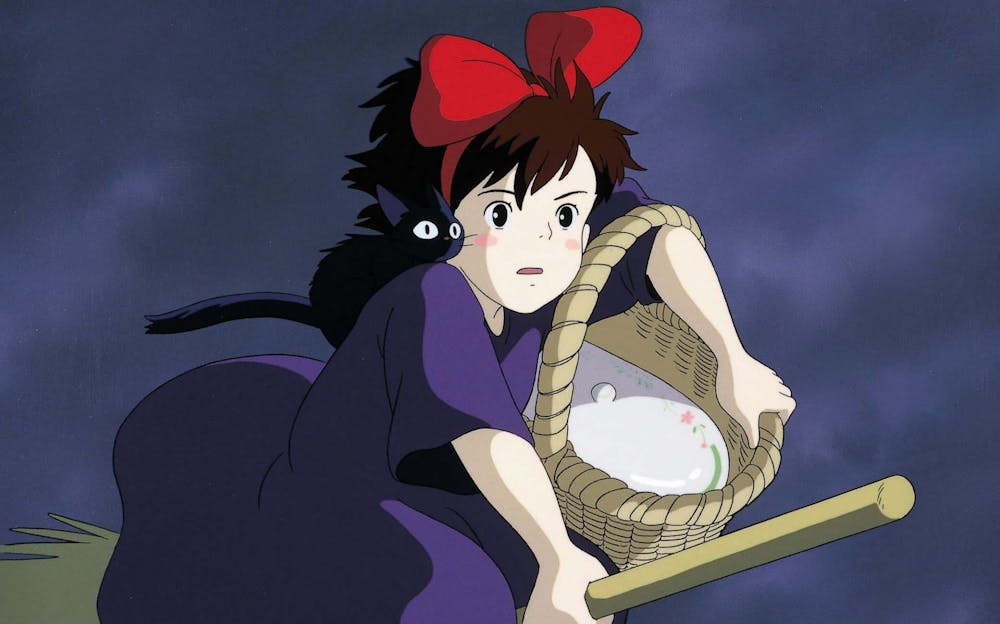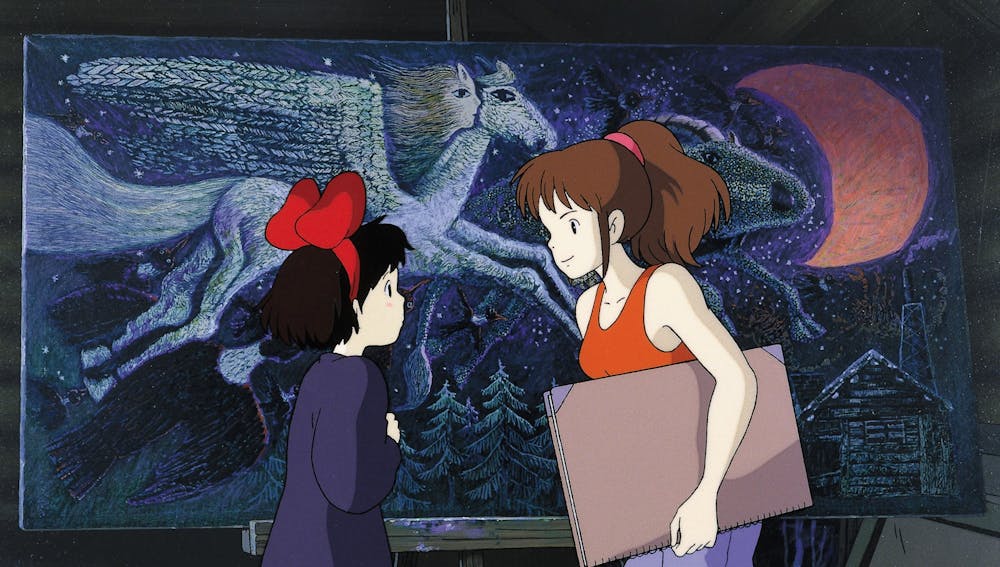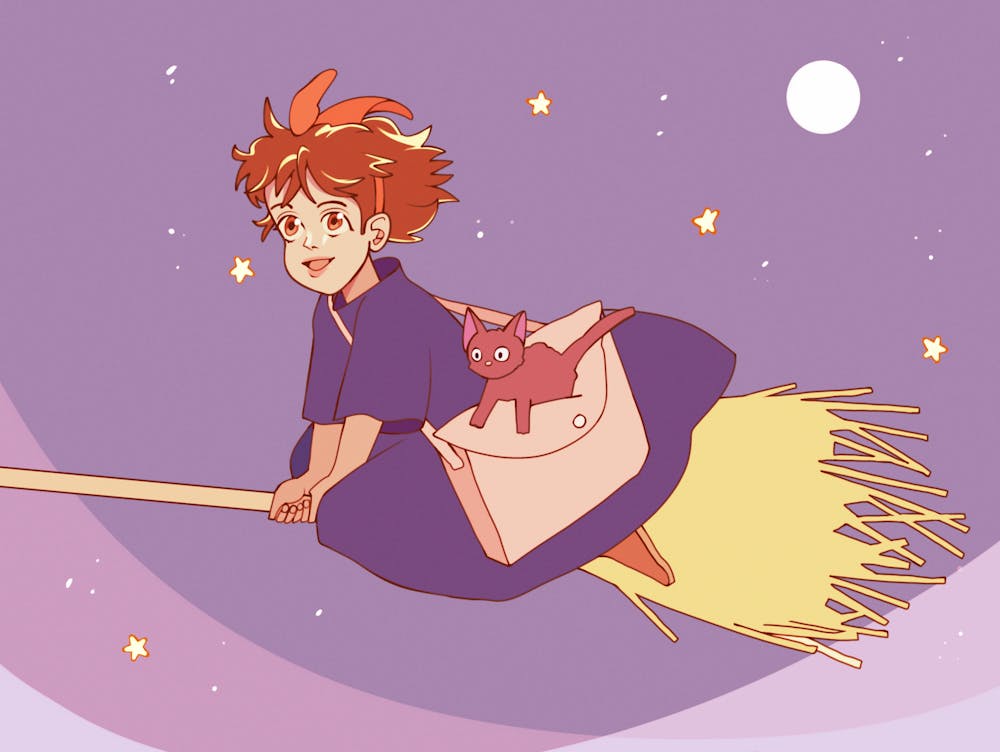If I had to choose my favorite Studio Ghibli film, I would choose Kiki’s Delivery Service in a heartbeat. A whimsical story following a 13–year–old witch named Kiki, this movie has been an unexpected source of comfort in helping me navigate my own struggles with inspiration and self–doubt. As a timeless classic and comforting coming–of–age story, the animation is a much–needed representation of creative burnout and the journey towards rekindling the “witch’s spirit” within ourselves.
On the night of the full moon, Kiki decides to embark on her yearlong witch training in a new town. She eventually arrives at her location of choice and meets Osono, a bakery owner, who offers her a place to stay in the vacant bedroom in her attic. With little money to sustain herself, Kiki decides to utilize her flying ability to start a delivery service business.
Kiki’s enthusiasm and resilience shines from the very beginning of the film. Although she primarily starts her business to make money, Kiki puts her full effort into every task she is given. At only 13 years old, she proves to be more than capable of being independent. However, she also dangerously sacrifices her needs and desires for the sake of others: She neglects her health to make deliveries in the pouring rain, misses out on social events with the other kids in town, and budgets all her money on groceries, even though she wants to have more than one pair of shoes. Kiki simply can't afford to experience her youth, and she's forced to brave a storm of responsibilities, stress, and loneliness, all while adjusting to a new environment.
Her pure optimism slowly wanes into a sense of hopelessness as every delivery she makes becomes unfulfilling. Flying, a skill that used to be an innate ability for her as a witch, is now just a burden for her career.

One morning, Kiki suddenly realizes that she can no longer fly, which only pushes her into a further state of dejection. She heartbreakingly tells Osono, “I’m still training to be a witch. If I lose my magic, that means I’ve lost absolutely everything.”
Whether our burnout is a result of our own expectations or out of monetary necessity, not being able to access the talents and skills we once took for granted is a terrifying feeling. Kiki’s struggles reflect the experiences of many creatives: The disillusionment we feel as activities we once enjoyed become burdens, instead of sources of happiness.
During her delivery hiatus, Kiki takes a break with her friend Ursula, a painter whom she met in the forest on her first delivery adventure. Kiki’s friendship with Ursula is one of the most important things that helps her rekindle her spark. The artist tells Kiki that painting and magical powers appear to be very similar—both the “witch and artist’s spirit” are abilities that can come and go with our state of mind. Ursula shares her own experiences with creative burnout, saying, “I loved painting—so much that I couldn’t sleep. Then one day, for no reason, I became unable to paint. So I just kept on painting anyway, but still it was no good. I realized that I was just imitating other painters—just copies of paintings I’d seen somewhere.”

Whenever she feels herself falling into a slump, Ursula says that it’s sometimes necessary to take a step back. “At times like that, you know what I do? Paint. That gets rid of my frustrations … Then I just stop. Take long walks, look at the scenery, doze off at noon. Don’t do a single thing. Then, suddenly I’m able to paint again.” Ursula's words are not only a source of comfort to Kiki, but they also serve as a constant reminder to extend patience and compassion to ourselves. Not everything we do has to be efficient or profitable, and taking care of our well–being is a priority itself.
Kiki’s Delivery Service also crucially highlights the importance of compensating people for their labor. Kiki often undervalues her work; throughout the entire film, she never explicitly asks for any payment, nor does she set a quote for her deliveries. All of her clients, however, make sure to properly pay her for her services. Even for tasks that Kiki deems simple and insignificant, Osono insists that “work is work” and should be properly compensated. Madame—the grandmother who is Kiki’s second client—makes sure to give Kiki her payment, even when she attempts to leave in a hurry for her delivery. When Kiki protests that the pay is too much, Madame simply replies, “Not for what you’ve done.”
The film makes clear that our time, energy, and labor is always worth money and appreciation.
While Kiki is paid for her work, many creatives in the real–life industry are not. Artists’ labor and ideas are frequently exploited in the market, with industry employers cutting corners, missing payments, or even asking creatives to work for free. A recent study finds that the underlying reason is “passion exploitation”: People consider exploitation to be more fair and socially legitimate if the worker appears to be passionate about their job. In a capitalist culture that “encourages us to find our life’s calling at work,” companies use the enjoyment that artists may derive from their jobs as a justification for improper compensation, poor working conditions, and use of unethical labor.
Kiki's story sheds light on both the internal struggles of creatives in rediscovering their passions, and the external necessity of proper payment for their work. More than just a comfort film, Kiki’s Delivery Service is an important narrative about valuing our labor and inherent self–worth.

